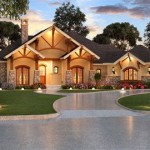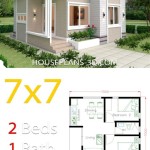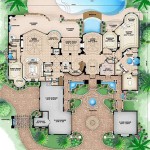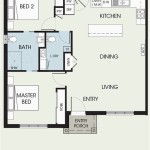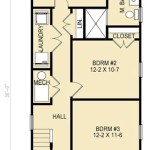Passive Solar House Plans for Cold Climates
Passive solar house design leverages the sun's energy for heating and lighting, reducing reliance on conventional heating and cooling systems. In cold climates, optimizing passive solar design is crucial to maintaining comfortable indoor temperatures and minimizing energy consumption. This article explores key principles and design considerations for passive solar house plans specifically tailored for cold regions.
Optimizing Solar Gain
The primary objective of passive solar design in cold climates is maximizing solar gain during the heating season. Solar gain refers to the amount of solar radiation that enters a building and is converted into heat. Several strategies contribute to effective solar gain:
Orientation: The house should be oriented to maximize southern exposure. In the Northern Hemisphere, the longest side of the house, particularly where windows are located, should face south (or slightly east or west of south, depending on site-specific conditions). This orientation allows for maximum sunlight penetration during the winter months when the sun is lower in the sky.
South-Facing Windows: Large, south-facing windows are essential for capturing solar energy. The size and placement of these windows should be carefully calculated based on the local climate, the building's thermal mass, and the desired heating load. Window glazing should be selected for its high solar heat gain coefficient (SHGC), which indicates the fraction of solar radiation that is admitted through the window. Low-emissivity (low-E) coatings can further improve the energy performance of windows by reducing radiative heat loss.
Overhangs and Shading: While maximizing solar gain is vital during the winter, preventing overheating in the summer is equally important. Overhangs, awnings, or strategically placed deciduous trees can provide shading for south-facing windows during the summer months when the sun is higher in the sky. Deciduous trees are particularly beneficial as they lose their leaves in the fall, allowing sunlight to penetrate during the winter heating season.
Solar Azimuth and Altitude: Understanding the sun's path is critical for effective passive solar design. Solar azimuth refers to the sun's horizontal angle relative to true south, while solar altitude refers to the sun's vertical angle above the horizon. These angles vary throughout the year, and designers must consider these variations when determining the optimal orientation, window placement, and shading strategies for a passive solar house.
Consideration of Obstructions: Existing structures, trees, or landforms can obstruct sunlight and reduce solar gain. It is crucial to assess the site for potential obstructions and adjust the building's design or placement accordingly. Solar site analysis tools can help determine the impact of obstructions on solar access throughout the year.
Enhancing Thermal Mass
Thermal mass refers to a material's ability to absorb, store, and release heat. In passive solar design, thermal mass plays a crucial role in regulating indoor temperatures and preventing temperature fluctuations. High thermal mass materials, such as concrete, brick, stone, and water, can absorb solar energy during the day and release it slowly at night, helping to maintain a stable and comfortable indoor climate.
Placement of Thermal Mass: For optimal performance, thermal mass should be located where it can directly absorb sunlight or be in close proximity to areas that receive direct sunlight. For instance, a concrete slab floor exposed to sunlight or a brick wall behind a south-facing window can effectively store and release heat.
Direct Gain Systems: In a direct gain system, sunlight enters the building through south-facing windows and is absorbed by thermal mass elements within the space. This is the simplest and most common type of passive solar heating system. The amount of thermal mass required depends on the size of the windows, the climate, and the desired temperature range.
Indirect Gain Systems: Indirect gain systems, such as Trombe walls and sunspaces, separate the thermal mass from the living space. A Trombe wall is a dark-colored, massive wall located behind a south-facing window. Sunlight heats the wall, which then radiates heat into the living space. A sunspace or greenhouse is a glazed area attached to the south side of the house. The sunspace collects solar energy, which can then be transferred to the house through vents or thermal mass connections.
Thermal Mass Considerations: The thermal mass must be properly insulated from the exterior to prevent heat loss. The color and surface texture of the thermal mass can also affect its performance. Dark-colored surfaces absorb more sunlight than light-colored surfaces, while rough textures can increase the surface area for heat transfer. It's also important to avoid covering thermal mass with rugs or furniture that would reduce its effectiveness.
Seasonal Considerations: In cold climates, managing the thermal mass's heat storage capacity is critical. During extended periods of cloudy weather, the thermal mass may become depleted. Supplemental heating systems, such as high-efficiency furnaces or wood stoves, may be necessary to maintain comfortable indoor temperatures during these periods.
Minimizing Heat Loss
While maximizing solar gain and utilizing thermal mass are essential for passive solar heating, minimizing heat loss is equally crucial, especially in cold climates. Heat loss can occur through various pathways, including walls, roofs, windows, doors, and air leaks. Implementing effective insulation and air sealing strategies is therefore paramount.
High Levels of Insulation: Walls, roofs, and floors should be adequately insulated to reduce heat transfer. Insulation levels are typically specified using R-values, which measure the resistance to heat flow. Higher R-values indicate better insulation performance. The specific insulation levels required depend on the local climate and building codes. Common insulation materials include fiberglass batts, cellulose, spray foam, and rigid foam boards.
Air Sealing: Air leaks can account for a significant portion of heat loss in buildings. Air sealing involves sealing cracks, gaps, and penetrations in the building envelope to prevent air infiltration and exfiltration. Common areas where air leaks occur include around windows and doors, where pipes and wires enter the building, and at the junction between walls and roofs. Air sealing can be accomplished using caulk, weather stripping, spray foam, and specialized sealing tapes.
High-Performance Windows and Doors: Windows and doors are often the weakest points in a building's thermal envelope. High-performance windows and doors can significantly reduce heat loss. Features such as multiple panes of glass, low-E coatings, and insulated frames can improve the energy performance of windows and doors. Air tightness is also crucial. Doors with tight seals and weather stripping minimize air leakage.
Reducing Thermal Bridging: Thermal bridging occurs when heat flows through a highly conductive material that penetrates the insulation layer. For example, metal studs in a wall can act as thermal bridges, allowing heat to escape from the building. Strategies for reducing thermal bridging include using thermally broken materials, wrapping the building with continuous insulation, and staggering framing members.
Earth Sheltering: Building partially or fully underground can provide significant thermal benefits in cold climates. The earth acts as a natural insulator, reducing heat loss in the winter and keeping the building cooler in the summer. Earth-sheltered homes typically have lower heating and cooling loads compared to conventional above-ground homes.
Efficient Ventilation: While minimizing air leaks is important, adequate ventilation is also necessary for maintaining indoor air quality. Mechanical ventilation systems, such as heat recovery ventilators (HRVs) and energy recovery ventilators (ERVs), can provide fresh air while minimizing heat loss. HRVs transfer heat from the outgoing exhaust air to the incoming fresh air, while ERVs transfer both heat and moisture.
Buffer Zones: Unheated spaces like garages, porches, or entryways can act as buffer zones, reducing heat loss from the primary living areas. These spaces can also provide storage and transitional areas between the interior and exterior.
In conclusion, designing a passive solar house for cold climates requires careful consideration of solar gain, thermal mass, and heat loss. By optimizing these factors, it is possible to create comfortable, energy-efficient homes that reduce reliance on conventional heating systems and minimize environmental impact.

Passive Design Strategies For Cold Climate

Passive Design Strategies For Cold Climate

The Next Generation Of Passive Solar For Cold Climates Construction

Passive Solar House Design Ecoliv

Passive Solar House Design Homes Kept Warm By The Sun Ecohome

Passive Solar House Design

Diy Passive Solar House Plans To Design Details Ecohome Green Building Guide Part 1

A Simple Design Methodology For Passive Solar Houses
Passive Solar Energy Efficient Home The House On Hill Coveney Browne Architects

Passive Heating Yourhome

